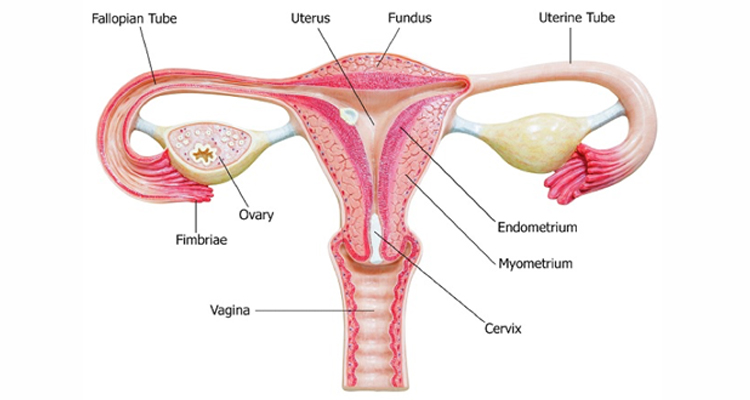
Vaginal Discharge
Vaginal discharge is the term for fluid or mucus that comes from the vagina. Vaginal discharge is a common concern among women, and leads many women to see their GP or gynaecologist. Some amount of vaginal discharge is normal, unless it occurs with itching, burning, or other bothersome symptoms. Most experts recommend an examination to determine the cause because different causes can have similar symptoms.
It is important to have a basic understanding of the female reproductive anatomy. Vaginal discharge is not usually noticeable until it exits the vagina, which is the passage from the uterus to the outside of the body. At the top end (inside) of the vagina is the cervix, while the lower end (outside) leads to the vulva and labia. The vulva is the name for the skin around the vaginal opening.
Is My Vaginal Discharge Normal?
Vaginal discharge is made by the skin cells of the vagina and cervix under the influence of the female hormone, oestrogen. Women who are menopausal normally have minimal vaginal discharge as a result of lower levels of oestrogen.
In women who are premenopausal, it is normal to have about one-half to one teaspoon (2 to 5 mL) of white or clear, thick, mucus-like, and mostly odourless vaginal discharge every day. However, the amount and consistency of the discharge varies from one woman to another. The amount can also vary at different times during the menstrual cycle. It may become more noticeable at certain times, such as during pregnancy, with use of birth control pills/patch/vaginal ring, near ovulation, and in the week before the menstrual period.
Normally, vaginal discharge contains vaginal skin cells, bacteria, and mucus and fluid produced by the vagina and cervix. A normal discharge often has a slight odour and may cause mild irritation of the vulva. This discharge helps to protect the vaginal and urinary tract against infections and provides lubrication to the vaginal tissues.
When To Seek Help For Vaginal Discharge
Vaginal discharge is common and normal. However, vaginal discharge with the following signs and symptoms is not normal and should be evaluated by a doctor or specialist nurse:
- Itching of the vulva, vaginal opening, or labia
- Redness, burning, soreness, or swelling of the vulval skin
- Foamy or greenish-yellow discharge
- Bad odour
- Blood-tinged vaginal discharge
- Pain with intercourse or urination
- Abdominal or pelvic pain
Causes Of Abnormal Vaginal Discharge
The most common causes of vaginal discharge include:
- A vaginal infection (yeast e.g. Candida albicans or bacterial infection eg. Trichomonas vaginalis). Some infections are sexually transmitted. If a sexually transmitted infection is confirmed, partner testing is usually recommended.
- The body’s reaction to a foreign body (such as a forgotten tampon or condom) or substance (such as spermicide, soap).
- Changes that occur after menopause can cause vaginal dryness, especially during sex, as well as a watery vaginal discharge.
A doctor should take a detailed medical and sexual history from any woman presenting with abnormal discharge. A gynaecological examination will usually involve examination of the entire outer genital area as well as an internal examination. As part of the examination, swabs from the vulval area, within the vagina and neck of the womb (cervix) may be taken with your consent to establish a formal diagnosis. Full investigation should include testing for a range of sexually transmitted infections including chlamydia, syphilis and gonorrhoea.
Treatment Of Abnormal Vaginal Discharge
In some cases it is possible to make a diagnosis and begin treatment immediately, based upon the examination. In other cases it may be better delaying treatment until test results are available.
Sexual partners of women with a sexually transmitted infection, such as chlamydia, gonorrhoea, syphilis or trichomonas, need evaluation and treatment. For other infections, such as yeast or bacterial vaginosis, the sexual partner does not need treatment.
If treatment is needed, you should avoid having intercourse until the treatment is completed. Women who develop bacterial or yeast infections frequently may be advised to use a preventative treatment.
Healthy Hygiene
Abnormal vaginal discharge may be more likely to develop in women who practice certain habits, such as those who use:
- Douches
- Pantyliners every day
- “Feminine hygiene” sprays, powders, or rinses
- Bubble baths or other scented bath products
- Tight or restrictive synthetic clothing (eg, thongs, synthetic underwear)
Healthier practices include the following:
- Use water or unscented non-soap cleanser to wash genitalia, use warm (not hot) water and the hand (not a washcloth).
- Do not douche or use feminine hygiene products; if odour or discharge is bothersome, see a doctor or specialist nurse.
- Avoid hot baths with scented products; plain warm water is preferred.
- Wear cotton underwear; avoid thongs and lycra underwear.
- Rinse genitals with water and/or pat dry after toileting; avoid use of baby wipes or scented toilet paper.